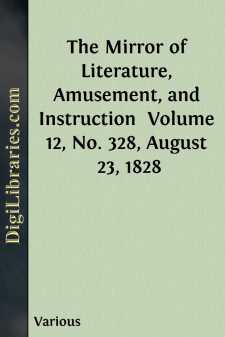Categories
- Antiques & Collectibles 13
- Architecture 36
- Art 48
- Bibles 22
- Biography & Autobiography 813
- Body, Mind & Spirit 142
- Business & Economics 28
- Children's Books 15
- Children's Fiction 12
- Computers 4
- Cooking 94
- Crafts & Hobbies 4
- Drama 346
- Education 46
- Family & Relationships 57
- Fiction 11829
- Games 19
- Gardening 17
- Health & Fitness 34
- History 1377
- House & Home 1
- Humor 147
- Juvenile Fiction 1873
- Juvenile Nonfiction 202
- Language Arts & Disciplines 88
- Law 16
- Literary Collections 686
- Literary Criticism 179
- Mathematics 13
- Medical 41
- Music 40
- Nature 179
- Non-Classifiable 1768
- Performing Arts 7
- Periodicals 1453
- Philosophy 64
- Photography 2
- Poetry 896
- Political Science 203
- Psychology 42
- Reference 154
- Religion 513
- Science 126
- Self-Help 84
- Social Science 81
- Sports & Recreation 34
- Study Aids 3
- Technology & Engineering 59
- Transportation 23
- Travel 463
- True Crime 29
The Mirror of Literature, Amusement, and Instruction Volume 12, No. 328, August 23, 1828
by: Various
Categories:
Description:
Excerpt
ANCIENT PLAN OF OXFORD CASTLE.
By these mysterious ties the busy pow'r
Of mem'ry her ideal train preserves
Intire; or, when they would elude her watch,
Reclaims their fleeting footsteps from the waste
Of dark oblivion.
AKENSIDE
Gentle, courteous, and patient reader—to understand the above plan, it is requisite that you carry your mind's eye back to those troublous times when men enjoyed no protection, but in opposing force to force; and to a period when every man's house was his castle, though not in the metaphorical sense we have since been accustomed to apply these words, viz. to the protection and security of British subjects.
Few portions of our island have been more amply illustrated, by antiquarians, than OXFORD; and from one of these we learn that a Keep Tower, or Castle, existed here a considerable time before the conquest; for Alfred lived here; and Harold Harefoot was crowned and resided here; and one of Alfred's sons struck money here. Hearne has likewise identified this fact by the very ancient and original arms of Oxford, which have a castle represented, with a large ditch and bridge. Upon the same authority we learn that Offa "built walls at Oxford," and by him, therefore, a Saxon castle was originally built at Oxford.
Leland, Dugdale, and Camden, on the other hand, affirm that the castle at Oxford was built by Robert D'Oiley, who came into England with William the Conqueror; and the Chronicles of Osney Abbey, preserved in the Cottonian library, even ascertain the precise date of this great baron's undertaking, viz. A.D. 1071. No question, therefore, can remain, but that this illustrious chieftain either repaired or rebuilt the castle; but as we have shown, upon equal authority, there was a Saxon castle, fit for a royal residence at Oxford, long previous to D'Oiley's time. About the year 1794, several Saxon remains were discovered here; but our engraving represents the castle in Norman times, with Robert D'Oiley's magnificent additions, and is a facsimile of a plan by Ralph Agas, in 1538, which, allowing a little for bad or unskilful drawing, may be taken as a perfect specimen of Norman military architecture, and will, we are persuaded, be received by our readers as a popular and interesting illustration of the warlike character of the age in which the castle was erected.
For the description we are indebted to a MS. account of Anthony Wood, in the Bodleian library, who informs us that at one of its entrances was "a large bridge, which led into a long and broad entry, and so to the chief gate of the castle, the entry itself being fortified, on each side, with a large embattled wall; and having several passages above, from one side to the other, with open spaces between them, through which, in times of storm, whenever any enemy had broken through the first gates of the bridge, and was gotten into the entry, scalding water or stones might be cast down to annoy them."
On passing through the gate, at the end of this long entry, the fortification stretched itself, on the left hand, in a straight line, till it came to a round tower, that was rebuilt in the 19th of Henry III. And from thence went a fair embattled wall, guarded for the most part with the mill-stream underneath, till it came to the high tower joining to St....












